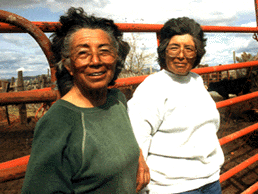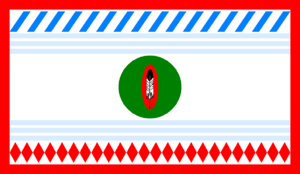Western Shoshone facts for kids
| Regions with significant populations | |
|---|---|
| Languages | |
| Shoshone, English | |
| Religion | |
| Native American Church, Sun Dance, traditional tribal religion, Christianity, Ghost Dance |
|
| Related ethnic groups | |
| other Shoshone people, Bannock |
| People | Neme Newe |
|---|---|
| Language | Neme Ta̲i̲kwappeh Newe Ta̲i̲kwappe |
| Country | Neme Segobia Newe Segobia |
The Western Shoshone are a group of Shoshone tribes. They are Native American people who have lived in the Great Basin area for a very long time. Their traditional lands are described in the Treaty of Ruby Valley 1863. These lands are found in parts of Idaho, Nevada, California, and Utah.
The Western Shoshone tribes are culturally similar to other nearby tribes. These include the Paiute, Goshute, Bannock, Ute, and Timbisha tribes. They speak the Western dialect of the Shoshone language. Other groups who speak Shoshone include the Goshute (near the Utah-Nevada border), Northern Shoshone (in southern Idaho), and Eastern Shoshone (in western Wyoming).

Contents
Western Shoshone Bands
Western Shoshone groups are often called "bands." Their names come from their traditional homelands and the main foods they ate.
- Kuyatikka (Bitterroot Eaters): These bands lived near Halleck, Mary's River, Clover Valley, and Smith Creek Valley in Nevada.
- Mahaguadüka (Mentzelia Seed Eaters): They lived in the Reese River and Ruby Valley areas of Nevada.
- Painkwitikka (Fish Eaters): This band lived in Cache Valley, which is in Idaho and Utah.
- Tipatikka (Pinenut Eaters): This was the northernmost band, living in northern Utah.
- Tosawiˑccɨh (White Knife Shoshone): This group lived near Battle Mountain, Nevada.
- Tsaiduka (Tule Eaters): They lived in Railroad Valley, Nevada.
- Tsogwiyuyugi: This band was found in Elko County, Nevada.
- Waitikka (Ricegrass Eaters): They lived in Ione Valley, Nevada.
- Watatikka (Ryegrass Seed Eaters): This band lived in Ruby Valley, Nevada.
- Wiyimpihtikka (Buffalo Berry Eaters): They lived in Big Smoky Valley, Nevada.
Federally Recognized Tribes
Many Western Shoshone tribes are officially recognized by the United States government. These include:
- Duckwater Shoshone Tribe of the Duckwater Reservation, Nevada
- Ely Shoshone Tribe of Nevada
- Fort McDermitt Paiute and Shoshone Tribes of the Fort McDermitt Indian Reservation, Nevada and Oregon
- Northwestern Band of the Shoshone Nation, Utah
- Paiute-Shoshone Tribe of the Fallon Reservation and Colony, Nevada
- Reno-Sparks Indian Colony, Nevada
- Shoshone-Paiute Tribes of the Duck Valley Reservation, Nevada
- Te-Moak Tribe of Western Shoshone Indians of Nevada
- Yomba Shoshone Tribe of the Yomba Reservation, Nevada.
Protecting Their Land
The Western Shoshone have been in long legal fights with the U.S. government. These fights are about who truly owns their land. The Shoshone believe their land was never properly taken from them.
The Ruby Valley Treaty
During the American Civil War (1861–1864), the U.S. government needed gold from the West. In 1863, the U.S. signed the Treaty of Ruby Valley with the Western Shoshone. This treaty described their territory, which was about 40,000 square miles. The treaty said the U.S. would pay the Shoshone $5,000 a year for 20 years. However, the Western Shoshone never agreed to give up their land. The U.S. government only made the first payment.
Ongoing Land Disputes
In 1951, a claim was made that the Shoshone land had been taken. In 2004, the U.S. government tried to pay $160 million for about 39,000 square miles of land. This payment was meant to settle the land claims. However, the Western Shoshone leaders mostly opposed this. They said they wanted the U.S. to follow the 1863 treaty and stop using their lands without permission.
In 1985, the U.S. Supreme Court made a ruling. It said that when Congress set aside money for the land claims, it meant the Shoshone's land rights were "presumed to be extinguished." But the tribes have left the money with the government. They still believe the land is theirs.
The Western Shoshone continue to protect their property. They have protested against nuclear testing on their land. They have also tried to stop gold mining that would dry up water sources near Mount Tenabo, Nevada. Their fight for land rights is shown in the 2008 film American Outrage. The United Nations has also recognized their struggle.
Western Shoshone Passports
Since 1992, the Western Shoshone have issued their own passports. In 2010, a Western Shoshone elder named Carrie Dann used her Western Shoshone passport. She traveled to the World People's Conference on Climate Change and the Rights of Mother Earth in Cochabamba, Bolivia. This shows how they see themselves as a sovereign nation. You can learn more about similar passport issues by looking up the Iroquois passport.
Notable Western Shoshone People
- Ned Blackhawk (Te-Moak): A well-known historian and professor at Yale University.
- Carrie Dann: An elder and important activist for land rights.
- Mary Dann: An elder and activist who worked alongside her sister, Carrie, for land rights.
- Corbin Harney: An elder and activist who spoke out against nuclear weapons.
See also
- Spring Valley Massacre of 1859
- Western Shoshone Claims Distribution Act of 2004


